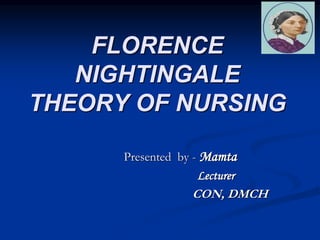
1._NIGHTINGALE_THEORY.ppt
- 1. FLORENCE NIGHTINGALE THEORY OF NURSING Presented by - Mamta Lecturer CON, DMCH
- 2. INTRODUCTION Florence Nightingale was borne in Florence, Italy, on 12th May,1820. She had a broad knowledge of science, mathematics, literature, philosophy, history, politics, economics & arts. She became a heroine in Great Britain as a result of her work in the Crimean war
- 3. During the Crimean campaign, Florence Nightingale gained the nickname "The Lady with the Lamp", Florence Nightingale Began her nursing training in 1851 in Germany Pioneered the concept of formal nursing education. Her experience in treating sick/injured soldiers in the Crimean War strongly influenced her philosophy of nursing. She died on 13th August, 1910.
- 4. Nightingale’s Environmental Model Nightingale viewed the manipulation of the physical environment as a major component of nursing care. She identified ventilation, warmth, light, noise, variety, bed and bedding, cleanliness of rooms & walls & nutrition as major areas of the environment the nurse could control. When one or more aspects of the environment are out of balance the client must use increased energy to counter the environmental stress.
- 5. Health of houses Ventilation & warming
- 6. Light Noise Bed & Bedding
- 7. Personal cleanliness Nutrition & taking food
- 8. Nightingale’s environmental model & nursing’s metaparadigm Nightingale did not invent or define the four major concepts used to organise theory. They evolved from an analysis of nursing curricula. The four concepts according to her are- NURSING- “what nursing has to do…….is to put the patient in the best condition for nature to act upon him.” Nightingale stated that nursing “ought to signify the proper use of fresh air, light, warmth, cleanliness & proper selection & administration of diet – all at the least expense of vital power to the patient.”
- 9. Based on her definition of nursing, the following definitions of human beings, environment, and health can be deduced. HUMAN BEINGS- human beings are not defined by Nightingale specifically. They are defined in relationship to their environment & the impact of the environment upon them
- 10. ENVIRONMENT- she focused on ventilation, warmth, noise, light & cleanliness. HEALTH-she did not define health specifically. She believed “nature only cures.” she believed that nursing should provide care to healthy as well as the ill and discussed health promotions an activity in which nurses should engage.
- 11. NURSE OBSERVER PRACTITIONER ENVIRONMENT client NURSE VARIETY LIGHT BEDDING CLEANLINESS CHATTERING HOPES HEALTH OF HOUSES AIR NOISE VENTILATION
- 12. NIGHTINGALE AND THE NURSING PROCESS In the assessment of clients Nightingale advocated two essential behaviors by the nurse- (1) ask the client what is needed or wanted (2) observation of the patient
- 13. Nursing diagnosis are based on Analysis of the conclusions gained from the information in the assessment
- 14. Planning includes identifying the nursing actions needed to keep clients comfortable, dry & in the best state for nature to work on. It is focused on modifying the environment to enhance the client’s ability to respond to the disease process.
- 15. Implementation takes place in the environment that affects the client & involves taking action to modify that environment. Evaluation is based on the effect of the changes in the environment on the client’s ability to regain their health at the least expense of their energy.
- 16. Nightingale’s model for nursing practice
- 17. Nightingale & the characteristics of a theory Theories can interrelate concepts in such a way as to create a different way of looking at a particular phenomena. Theories must be logical in nature Theories must be relatively simple yet generalizable Theories can be used by practitioners to guide and improve their practice.
- 18. Theories must be consistent with other validated theories, laws & principles but leave open unanswered questions that need to be investigated.